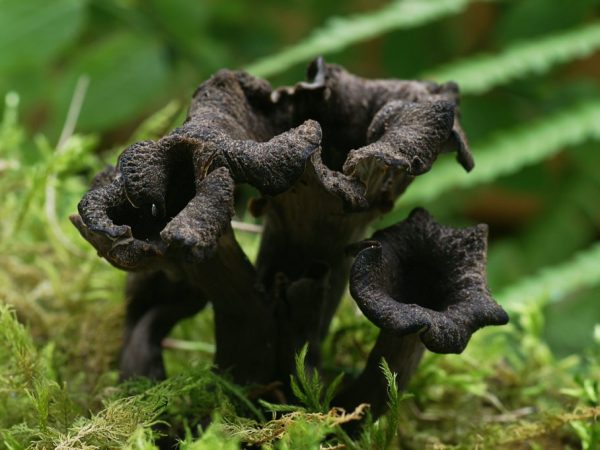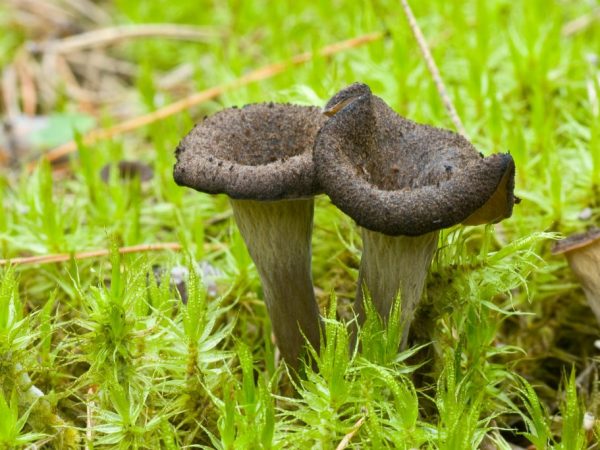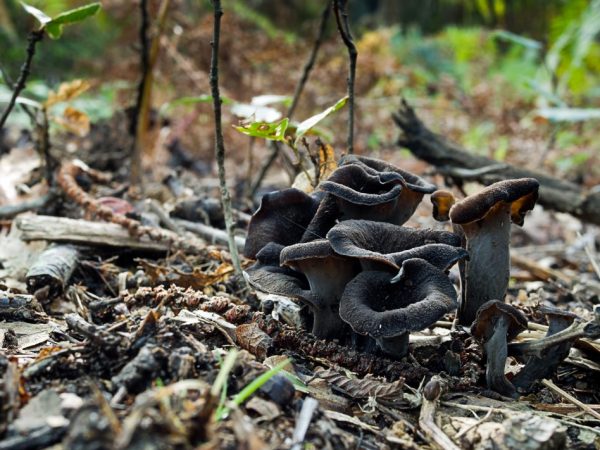Horn-shaped mushroom
The horn-shaped funnel is a representative of the Chanterelle family. It belongs to the class Agaricomycetes.

Horn-shaped mushroom
Botanical characteristic
The fruit body of the mushroom is horn-shaped funnel, which has a characteristic shape in the form of a tube or cup, tapering towards its base. The length of the fruiting body is 5-12 cm; its structure is empty (hollow). This bowl has a gradual transition to a mushroom leg. In this case, the deepening of the cap smoothly passes into the cavity of the leg (through).
Other names of the fungus are the horn-shaped tube mushroom, gray and funnel-shaped funnel-shaped, horn-shaped craterellus. By the way. He is mistakenly called the gray chanterelle.
The mushroom cap looks like a funnel, it grows up to 3-8 cm in diameter. In young specimens, the edges are wavy, turned outward, in adults they develop into torn or lobed ones.
The inner surface of the mushroom fruiting body has a fibrous structure and is covered with small scales. The color of the upper surface depends on the age of the fungus:
- the color of young specimens is brown-black,
- the fruiting body of an adult fungus is colored dark gray,
- the overgrown horn-shaped funnel becomes almost black.

The mushroom cap looks like a funnel, grows in diameter up to 3-8 s
The outer surface is covered with hymenium (spore-bearing layer), while in young specimens it is smooth, and as the specimen matures, it becomes lumpy and wrinkled. The color of the lower surface is initially gray-brown, then gray-gray, and in the process of spore maturation it becomes spattered. Sometimes there are also yellow specimens. The dried mushroom becomes much lighter.
Due to its specific shape, the inhabitants of Finland call the mushroom "black horn", the Germans call it "the pipe of the dead", the French call it the "pipe of death", and the British call it "cornucopia."
The fungus lacks hymenophore pseudoplates, which are inherent in many representatives of the Chanterelle family.
Irina Selyutina (Biologist):
The folded hymenophore, unlike its fellow lamellar hymenophore, is represented by rather thick folds of tissue, or, as they often say, wrinkles, on the surface of which a spore-forming layer is located - hymenium. Since these structures are not, in their essence, plates, but only resemble them externally, hence the prefix “pseudo-” came from. Mushrooms with this type of hymenophore are often described as lamellar.
The mushroom leg is short and narrow, no more than 0.8-1 cm in thickness. It narrows towards the base. The structure is tough. The color is similar to that of a mushroom cap.
The mushroom pulp is too thin, filmy, easily breaks down, initially gray or dark brown, almost black in adult mushrooms. The smell and taste of raw mushrooms are not noted, they are exacerbated in the process of drying and heat treatment.
Geography of distribution
Most mycologists classify the horn-shaped funnel from the Chanterelle family to mycorrhiza-forming organisms capable of creating a symbiotic association with the roots of a part of higher plants.However, some experts consider it to be living on the remains of living organisms, referring to the number of saprophytes.
The fungus grows more often in large crowded intergrown groups and colonies. It is difficult to detect due to its coloration similar to fallen leaves.
The fruiting season for the trumpet mushroom begins from the first days of July and lasts until the last days of September-early October, in regions with warm snowless winters - until November. Abundant mass appearance is observed from the second half of August to mid-September.
The funnel grower prefers to grow in deciduous and mixed forests in important areas, fallen oak and beech leaves, clay and limestone soils. It is most often found in open, illuminated places, near roads, on the edges of ditches and near paths. It is permissible to find mushrooms in mountainous areas.
The geography of distribution covers the temperate zone of the Northern Hemisphere, including tropical regions. The trumpet mushroom grows in European, North American and Asian territories, taking over Japan. In Russia, it is found in the regions of the North Caucasus, Altai and the Far East, the West Siberian plain and in the European part.
For your information. Best of all, the funnel pot "gets along" with pine and spruce, but it can grow quite well next to a beech or oak. But you are unlikely to succeed in "organizing" a friendship between garden trees and this amazing forest miracle.

The fungus grows in large crowded intergrown groups
Similar varieties
The horny tube-mushroom has varieties that are similar in external description, including:
- Sinuous funnel maker: it is distinguished from the horn-shaped funnel with a lighter, yellowish color and a strongly dissected mushroom cap.
- Chanterelle gray: on the underside of the mushroom cap it has a hymenophore, represented by pseudoplates.
- The goblet dumped: differs in the funnel-shaped form of the fruit body in the form of a glass of almost black color.
Practical use
The funnel is an edible mushroom. For Western European chefs, it is a delicacy. Suitable for use without preliminary heat treatment. For food purposes, use only a tubular mushroom funnel, removing the coarse stem. The mushroom is an ingredient in the preparation of various first and second courses, sauces and seasonings.
In the process of boiling, the horn-shaped mushroom becomes black.
It lends itself well to drying, but becomes brittle and crumbles. When dried, the palatability is enhanced.
Irina Selyutina (Biologist):
Since the horn-shaped funnel is able to accumulate various toxic compounds from the soil in its fruit bodies, it is better to use young mushrooms for food. Cooking mushrooms is used when harvesting them for the winter:
- The cleaned funnels are dipped into an enamel bowl and filled with water so that it covers them and put on fire.
- Add 0.5 tsp. citric acid and bring to a boil.
- Reduce heat and cook for 10-15 minutes, skimming off the foam.
- Transfer to a colander, allow to drain and rinse with cool water.
Again, let the water drain well and freeze.
There are many pigments in the fruit bodies of the funnelfoot, which give a specific black color, therefore, during cooking, the water becomes colored and becomes bluish-black. This "transformation" often scares people who first encounter a funneller.
Conclusion
The funnel mushroom is a member of the Chanterelle family. Edible, applicable in cooking even without preliminary processing, in a number of countries it is considered a delicacy.



